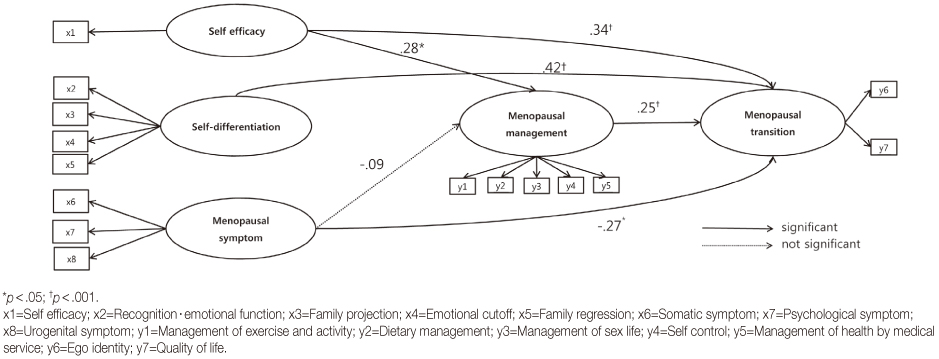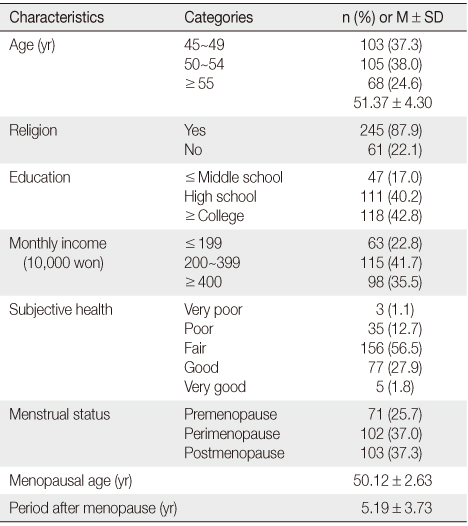Articles
- Page Path
- HOME > J Korean Acad Nurs > Volume 45(1); 2015 > Article
-
Original Article
- Structural Equation Modeling on Healthy Menopausal Transition
- Eunyoung Hong, Young Sil Kang
-
Journal of Korean Academy of Nursing 2015;45(1):64-75.
DOI: https://doi.org/10.4040/jkan.2015.45.1.64
Published online: February 27, 2015
1Department of Nursing, Koje College, Geoje, Korea.
2College of Nursing·Institute of Health Science, Gyeongsang National University, Jinju, Korea.
- Address reprint requests to: Kang, Young Sil. College of Nursing, Gyeongsang National University, 816-15 Beon-gil, Jinju-daero, Jinju 660-987, Korea. Tel: +82-55-772-8252, Fax: +82-55-772-8222, kangys@gnu.ac.kr
© 2015 Korean Society of Nursing Science
This is an Open Access article distributed under the terms of the Creative Commons Attribution NoDerivs License. (http://creativecommons.org/licenses/by-nd/4.0/) If the original work is properly cited and retained without any modification or reproduction, it can be used and re-distributed in any format and medium.
Abstract
-
Purpose
- This study was designed to construct and test structural equation modeling on healthy menopausal transition in middle-aged women in order to identify variables affecting healthy menopausal transition.
-
Methods
- Participants, 276 women, 45 to 60 years of age, with menopausal symptom score higher than 5 on the Korean version of Menopause Rating Scale, were recruited in three cities and one county of Gyeongnam Province. Research data were collected via questionnaires and analysed using SPSS version 18.0 and AMOS version 20.0.
-
Results
- After confirmatory factor analysis, one of the observed variables was excluded due to relatively low factor loading. The model fit indices for the hypothetical model were suitable for the recommended level: GFI=.93, CFI=.92, RMSEA=.05. Self-efficacy, self-differentiation, and menopausal symptoms explained 67.7% of variance in menopausal transition, and self-differentiation was the most influential factor for menopausal transition. Self efficacy and menopausal symptoms explained 9.6% of variance in menopausal management, although "menopausal symptoms" was not significant.
-
Conclusion
- These results suggest that nursing interventions to improve self-differentiation, self efficacy, menopausal management and decrease menopausal symptoms are critical for healthy menopausal transition in middle-aged women. Continued development of a variety of community-based nursing interventions to facilitate healthy menopausal transition is suggested.
This manuscript is a condensed form of the first author's doctoral dissertation from Gyeongsang National University.
- 1. Statistics Korea. 2012 life tables for Korea [Internet]. Daejeon, Author. 2013;cited 2013 December 20. Available from: http://kostat.go.kr/portal/korea/kor_nw/2/2/7/index.board
- 2. Kim SG, Kim YG, Cho AJ, Kim HR, Im SE. Report No.: Research Paper 2009-33. The 2009 national survey on fertility, family health and welfare in Korea. Seoul: The Korea Institute for Health and Social Affairs; 2009.
- 3. Harlow SD, Gass M, Hall JE, Lobo R, Maki P, Rebar RW, et al. Executive summary of the stages of reproductive aging workshop+10: Addressing the unfinished agenda of staging reproductive aging. Fertil Steril. 2012;97(4):843–851. ArticlePubMedPMC
- 4. Breheny M, Stephens C. Healthy living and keeping busy: A discourse analysis of mid-aged women's attributions for menopausal experience. J Lang Soc Psychol. 2003;22(2):169–189.
- 5. Kim MJ, Kim JH. How long do menopausal hot flushes really last? J Korean Soc Menopause. 2009;15(2):73–78.
- 6. Yoon JH, Han JH. A study on the psychological phenomenon experienced by menopausal middle-aged women. Korean J Couns. 2013;14(4):2195–2212.Article
- 7. Meleis AI, Sawyer LM, Im EO, Hilfinger Messias DK, Schumacher K. Experiencing transitions: An emerging middle-range theory. ANS Adv Nurs Sci. 2000;23(1):12–28.Article
- 8. Schumacher KL, Meleis AI. Transitions: A central concept in nursing. Image J Nurs Sch. 1994;26(2):119–127.ArticlePubMed
- 9. Yeo JH. Correlational study on management of menopause, marital satisfaction, and quality of life in middle-aged women. J Korean Acad Nurs. 2004;34(2):261–269.ArticlePDF
- 10. Lee KH, Chang CJ. Korean urban woman's experience of menopause: New life. Korean J Matern Child Health Nurs. 1992;2(1):70–86.
- 11. Im EO, Meleis AI. A situation-specific theory of Korean immigrant women's menopausal transition. Image J Nurs Sch. 1999;31(4):333–338.ArticlePubMed
- 12. Hong E, Kang YS, Ha Y. Factors affecting on health promoting behaviors among teachers with middle-aged women experiencing menopause. Korean J Occup Health Nurs. 2013;22(1):66–74.Article
- 13. Park CH, Oh EJ, Park JS. The relationships between menopausal symptoms, menopausal knowledge, menopausal attitude and menopausal management of middle aged women. J Korean Soc Matern Child Health. 2012;16(1):89–99.Article
- 14. Song AR. Development of and educational program for the management of menopause and it's effect. J Korean Acad Nurs. 1998;28(2):280–290.ArticlePDF
- 15. Lee KH. Relationships between role adaptations and identity formation of married mid-life women [dissertation]. Daegu, Keimyung University. 1998.
- 16. Byeon WJ, Kim CK. Effects of socio-demographic variables, self-differentiation and internal systems on ego-identity of middle-aged women. J Korean Home Econ Assoc. 2006;44(12):155–165.
- 17. Kim KS, Kim JR. The effects of ego-identity and crisis on quality of life in midlife married women. J Korean Home Econ Assoc. 2001;39(4):105–120.
- 18. Song HO, Park AC, Choi SY. A structure model analysis between a family environment, perceived social support, self-efficacy and ego-identity of adolescents. Korean J Youth Stud. 2010;17(2):109–129.
- 19. Jung YJ, Hong SR. Mediating effects of school life satisfactions and relationship satisfactions on the relations between self-efficacy and subjective quality of life in university students. J Adolesc Welf. 2012;14(3):239–257.
- 20. Royal College of Nursing. Menopause: Lifestyle and therapeutic approaches: RCN guidance for nurses, midwives and health visitors [Internet]. London, UK, Author. 2010;cited 2013 March 2. Available from: http://www.rcn.org.uk/development/publications
- 21. Ro YJ. An analytical study on the quality of life of the middle-aged in Seoul [dissertation]. Seoul, Yonsei University. 1988.
- 22. Lee YM, Schwarzer R, Jerusalem M. Korean adaptation of the general self-efficacy scale [Internet]. 1994;cited 2013 June 2. Available from: http://userpage.fu-berlin.de/~health/korean.htm
- 23. Bowen M. Theory in the practice of psychotherapy. In: Guerin PJ, editor. Family therapy: Theory and practice. New York, NY: Gardner Press; 1976. p. 42–90.
- 24. Je SB. The relationship between differentiation of self and dysfunctional behavior [dissertation]. Busan, Pusan National University. 1989.
- 25. Heinemann LA, Potthoff P, Schneider HP. International versions of the menopause rating scale (MRS). Health Qual Life Outcomes. 2003;1:28ArticlePMC
- 26. Heinemann LA, DoMinh T, Strelow F, Gerbsch S, Schnitker J, Schneider HP. The menopause rating scale (MRS) as outcome measure for hormone treatment? A validation study. Health Qual Life Outcomes. 2004;2:67PubMedPMC
- 27. Kim GS. Analysis structural equation modeling. Seoul: Hannarae Publishing Co.; 2010.
- 28. Lee SS. A study on the relationship between married adult's level of self differentiation and their life satisfaction. J Fam Relat. 2000;5(1):23–43.
- 29. Kim JT, Sim HS. The main characteristics of Bowen's psychodynamic family therapy in the context of self-differentiation. Korean J Fam Ther. 1993;1(1):31–45.
- 30. Kim YH, Ha EH, Shin SJ. A study on the menopausal symptoms and quality of life in middle aged women. J Korean Acad Nurs. 2003;33(5):601–608.ArticlePDF
REFERENCES
Figure & Data
REFERENCES
Citations

-
Factors influencing
seogeulpeum
among middle-aged Korean women
Hyeja Gu, Eunyoung Hong
Climacteric.2025; 28(1): 40. CrossRef - Middle-aged Korean women’s experiences of physical activity during the transition to menopause: a grounded theory approach
Hee Jung Cho, Sukhee Ahn
Women's Health Nursing.2025; 31(3): 215. CrossRef - Psychological well-being of midlife women: a structural equation modeling approach
Jiwon Lee, Jong-Eun Lee
Menopause.2022; 29(4): 440. CrossRef - A menopausal transition model based on transition theory
Jisoon Kim, Sukhee Ahn
Korean Journal of Women Health Nursing.2022; 28(3): 210. CrossRef - Experiences on Psycho-social Health Support of Middle-aged Women
Jeong-Soo KIM, Euna PARK
JOURNAL OF FISHRIES AND MARINE SCIENCES EDUCATION.2019; 31(5): 1432. CrossRef



Figure 1
Figure 2
Figure 3
General Characteristics of Subjects (N =276)
Standardized Estimates, CR, SMC, Standardized Direct, Indirect, and Total Effects for the Hypothetical Model
SE=Standardized estimates; CR=Critical ratio; SMC=Squared multiple correlation.
SE=Standardized estimates; CR=Critical ratio; SMC=Squared multiple correlation.
 KSNS
KSNS
 E-SUBMISSION
E-SUBMISSION





 Cite
Cite

